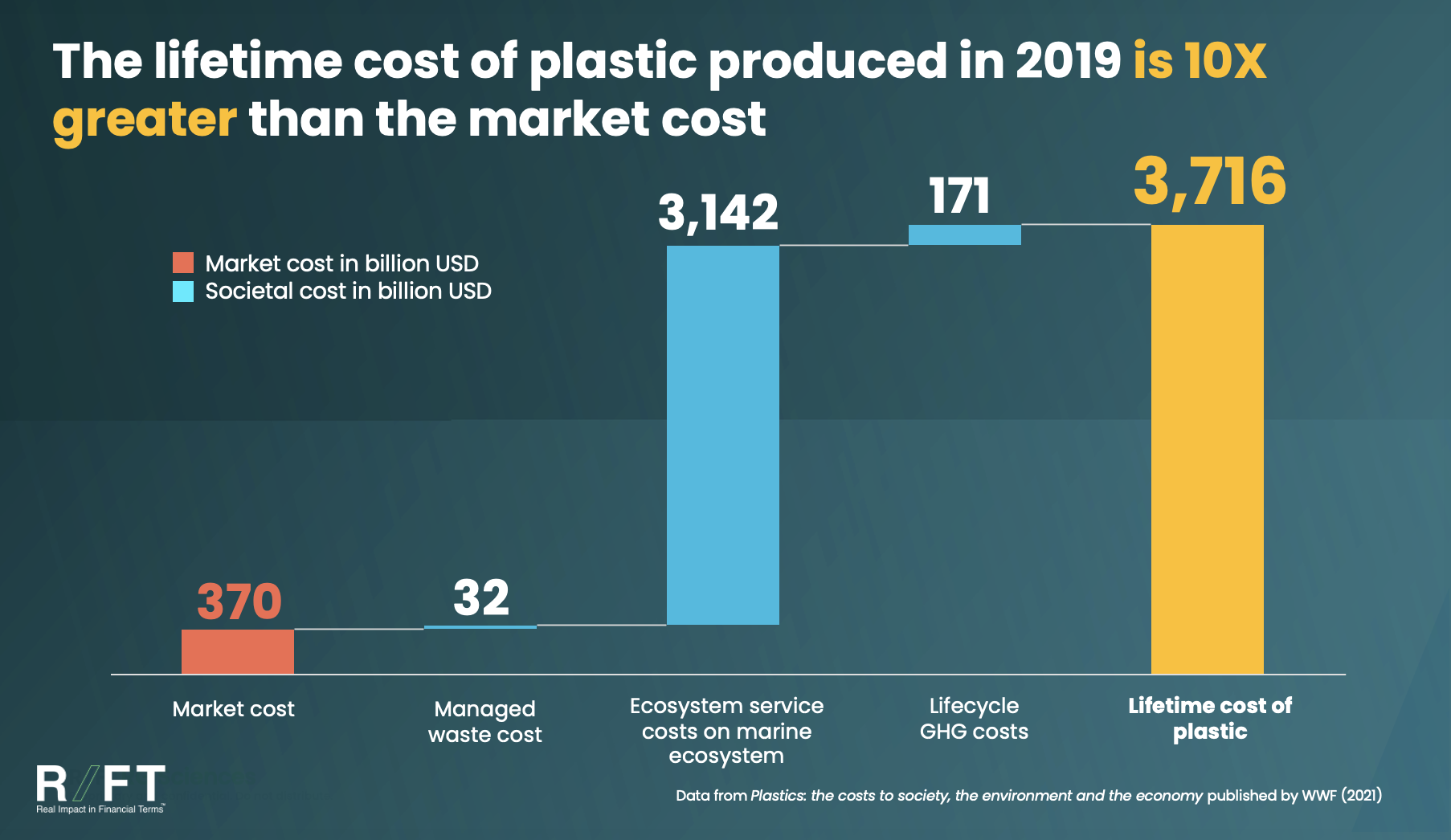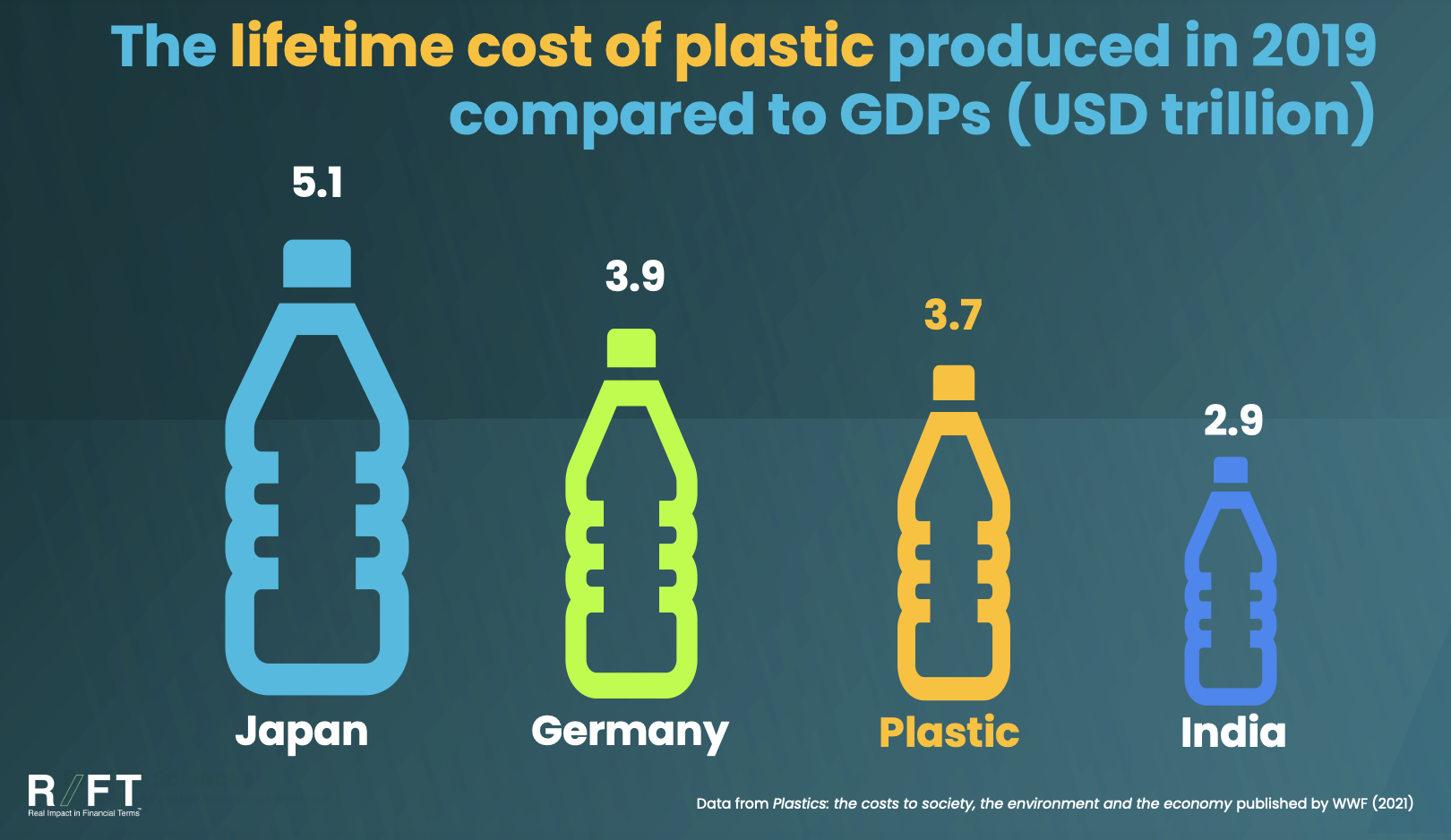Summer is here and sales of soft drinks are peaking [1]. As consumers, we are seeking more, refreshing and flavorful beverages to cool down ourselves and enjoy our barbeque parties with family and friends. However, there is a higher price of those cold fizzy drinks than what we pay for them at the till - and that partly boils down to the plastic bottle which comes with the product.
Beverages is one of many industries using plastics as packaging or product materials due to their unique properties of being lightweight, versatile, waterproof, and cheap. I mean that it is cheap for companies to buy plastics as raw materials, but costly for society. Even if it brings compelling benefits such as food safety and convenience, its durability along with failing waste management systems pose significant challenges.
In fact, the actual cost incurred over the plastic lifecycle is estimated to be at least 10x higher than its market price, and more than 85% of the cost occurs after plastic disposal [2]. So what is the actual cost of plastic, who is paying for it, why does it matter and which are the most polluting industries? This series of blog posts reveals new insights for you as a consumer, investor, or executive.
The true cost of plastics - $370 billion versus $3.7 trillion
Based on the price primary plastic producers paid for virgin plastic, the market cost of plastic produced in 2019 was around $370 billion, just over $1,000 per tonne.

According to a recent paper by WWF [2], however, the actual lifetime cost of plastic was estimated as US$3.7 trillion for just the plastic produced in 2019 - more than the GDP of India. This figure includes the market cost of plastic, plus the societal lifetime costs of 1) GHG emissions from production and waste management processes, 2) formal and informal waste management, and 3) unmanaged waste in the form of marine plastic pollution. In addition to these are the yet intangible costs, such as the impact of exposure to microplastics which have already been detected in human placentas [3] and human lung tissue [4].

Among these societal costs, marine plastic pollution has the worst quantified impact on society and environment. Even though “only” ~ 4% of total plastic production leaks into oceans annually - which is still 12 million tonnes of plastic waste [2] -, plastics take centuries or even millennia to degrade and continue to cause harm even in their most miniscule forms, thereby contributing to the US$3.7 trillion lifetime cost by 85%. As plastic waste poses a large threat to marine life, it leads to a reduction in ecosystem services provided by oceans, a deterioration of revenues for fisheries and tourism, and clean-up activity costs - just to name those costs that can be quantified.
All of these are paid directly or indirectly by governments and therefore by businesses and citizens via taxes or by the direct harm they experience. Hence, the lifetime cost of plastic is a large burden on society as a whole that should be taken into consideration by every decision maker - especially as the volume of plastic leaking into oceans is forecast to grow 3x in the upcoming 20 years [5].
The largest plastic polluter industries
Fast-moving consumer goods (FMCG) industries are in the spotlight when it comes to plastic pollution as packaging is the most dominant generator of plastic waste. In 2018, 36% of all primary production of plastic was used for packaging and c. 46% of the total global plastic waste was related to packaging [5]. Major FMCG companies have already identified plastic packaging as top 3 ESG issues to tackle and have been evolving their business strategy to gain competitive advantage in circular economy practices due to pressure coming from regulations (e.g. ban on single-use plastics) and rising consumer, employee and investor demand for sustainable practices.
Through the Global Commitment and the Plastics Pact Network of the Ellen MacArthur Foundation, there are already 63 brand & retail signatories committing to change their practices along the plastic lifecycle with concrete targets and yearly reporting [6]. For example, all these 63 brands and retailers have pledged to decrease virgin plastics packaging by 19% from 2018 to 2025. Still, c. 80% of this reduction is driven by increasing recycled plastics content which neither addresses the issue with single-use packaging nor provides a solution to eliminate the volume of plastics [6].
At RGS, we capture and quantify the real impact of companies to the world by focusing on the outcomes rather than the initiatives. Stay tuned for our next blog post of this series when we reveal our results for the first time on how the FMCG industries compare to each other in terms of annual volume of plastic packaging, what their relative performance is, how they improved (or not improved) over time, and how their impact translates into monetary terms.
—--------------------------------------
[1] https://grocerytrader.co.uk/sparkling-sales-fizzy-drinks-bring-summer-to-life/
[2] WWF – World Wide Fund For Nature, Plastics: the costs to society, the environment and the economy, (2021)
[3] Ragusa, A. et al., Plasticenta: First evidence of microplastics in human placenta, (2021) Environment International, 146.
[4] Amato-Lourenço LF, Carvalho-Oliveira R, Júnior GR, Dos Santos Galvão L, Ando RA, Mauad T., Presence of airborne microplastics in human lung tissue, (2021) J Hazard Mater
[5] WWF, the Ellen MacArthur Foundation and BCG, The business case for a UN treaty on plastic pollution, (2020)
[6] The Ellen MacArthur Foundation, The Global Commitment 2021 Progress Report, (2021)
Image from Unsplash
Chart data sources are from WWF – World Wide Fund For Nature, Plastics: the costs to society, the environment and the economy, (2021)



